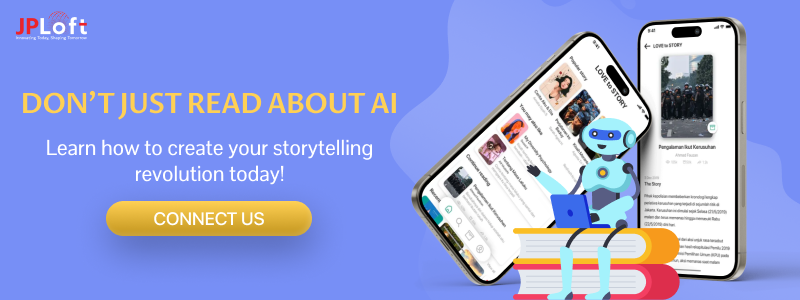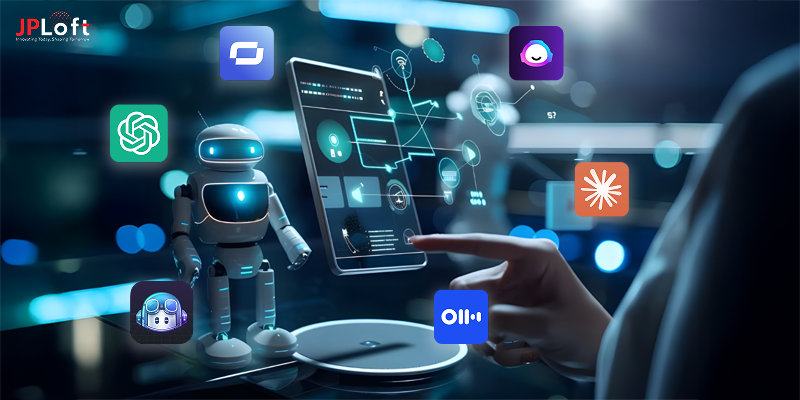Get ready to explore a new era where technology doesn't just assist writers, it creates the stories we crave.
“AI will probably be the best or worst thing ever for humanity." — Stephen Hawking”
Well, it can be the best thing if you optimize it for the benefit of the people.
However, in this competitive world, where people are switching to AI apps, it's essential to identify their preferences and then provide them with the potential solution.
When it comes to storytelling, the industry has evolved to engage the users who prefer to listen to stories over audio and video.
Hence, for the story lovers, an app that catches their interest and builds on AI can be an option to invest in.
Now, the question is “how to build AI Storytelling apps?”
Well, you need the right guidance, which begins with a market study and ends with maintenance. You have arrived at the right place to learn it all.
Here, we have discussed the concept, features, process, cost, and a lot more.
Let’s evaluate it all, together.
What Do The Stats Say?
The AI Storytelling apps assist users in creating stories, from generating initial ideas to developing plots, characters, and dialogue. These are the apps that are made by writers, parents, students, or anyone who is looking for creative assistance.
In this world where everyone has a story to tell, these apps provide them a platform to connect with the diversified people.
The storytelling market does emphasize the power of narratives in connecting with audiences, building brand loyalty, and driving engagement.
Let’s check out some of the stats in this section.
-
- The digital storytelling courses market size in this competitive environment has increased by USD 267.84 million at a CAGR of 9.87% between 2023 and 2028.
- Additionally, this market was estimated at USD 415.78 million in the year 2024, and is expected to reach USD 467.26 million in the year 2025, which is expected to reach USD 851.34 million by the year 2030.
- Storytelling boosts product value by up to 2,706%. An effective storytelling can lead to a 30% increase in conversion rates.
- There are 73.67% of respondents who use the stories to convey sales information to the users, who can be further converted to subscribe to the app.
- AI in the mobile app market size is expected to be worth around USD 354.09 billion. By the year 2034, from the year USD 21.33 billion in the year 2024, the market is expected to grow at a CAGR of 32.5% during the forecasted period from the year 2025 to the year 2034.
- The global AI app market size is estimated at USD 2,940 million in the year 2024, and is further projected to reach USD 26,362.4 million by the year 2030, growing at a CAGR of 38.7% from the year 2025 to 2030.
With these stats and detailed insights related to the market, are you ready to create an AI Storytelling app?
If you are still confused, then the following section can help.
Why Build an AI Storytelling App?
When you proceed to create an AI app, it's essential to know what the need is and how it will help in this dynamic future.
Let’s learn it all in this section.
1. Personalized Recommendations
Artificial intelligence is a technology that helps to collect valuable insights about users related to what they prefer the most, and how much they prefer story narratives.
This collected data is analysed and evaluated to provide crucial knowledge to the potential users who prefer to listen to stories. Hence, creating an AI storytelling app can be beneficial.
2. Overcoming Creative Blocks and Boosting Productivity
Building an AI storytelling app can help you boost the productivity of your business, through engaging the users who love to listen to stories.
Here, you can even ask people to narrate their real-life stories to others. It helps them to generate ideas, accelerate drafting, and promote new ideas.
3. Democratizing Storytelling
AI storytelling apps democratize storytelling by lowering the barriers to entry by making it simpler and easier for everyone to build and even share the narratives.
This refers to making the ability to create and share stories more accessible to everyone, regardless of their resources and background.
4. Create Immersive Experiences
With the help of AI storytelling apps, you can build an immersive experience through using AI for personalizing the narratives, generating realistic environments, and building interactive characters.
AI can build complex branching narratives, where the user's choices have a significant impact on the story direction and outcome. Character AI clone development can be done by identifying potential techniques.
5. Lowers Technical Barriers
You can implement the AI tools to lower the technical barriers for storytelling, allowing individuals with compelling ideas but even with less technical writing experience, to express their narratives more effectively.
In this context, you can hire a dedicated developer who can assist you in identifying the requirements for building AI storytelling apps.
With these reasons, are you ready to create an AI Storytelling app?
Yes?
Then let's look for the types of features you can include in it to achieve defined success.
Features to Include in a Storytelling App
Whether it's about creating perplexity AI or a chatbot like Repika, all contain important features that help users connect with them.
Hence, here the features of a storytelling app will help you in identifying the prolonged initiatives helpful in engaging the users and helping them to operate the app.
You cannot imagine an app without its key features, right?
Then, just explore the features to include in the storytelling app in this section.
► Install and Create Profile
This is a very basic feature in the AI storytelling apps, where the user can install the app from the Play Store or App Store, and can further create a profile on the same. You can find this feature in every app.
► Genre Selection
Under these features, you can allow the users to select the genre from various options such as Sci-fi, romance, horror, fantasy, etc, for tailoring the story to their preferences. This feature is useful in tailoring the story’s content, style, and even the user interface.
► Dialogue Generation
With the help of AI, you can create generative and realistic ideas for engaging dialogue between characters. Additionally, the AI will use your input to create the conversational characters in novels, short stories, and scripts.
► Text Input
The users can provide input in the form of text prompts, keywords, or general themes. This will help the users to generate narratives that are engaging and personalized. It does serve as a foundation for the AI to understand the user preferences, generate unique storylines, and more.
► Voice Synthesis
When the story gets generated, AI storytelling apps use the text-to-speech (TTS) technology for converting the written text into spoken words. An AI-driven voice synthesis strives to sound natural and expressive to enhance the experience.
► Selecting the Visual Components for Narratives
Identifying and selecting the visual components can promote storytelling through using the guidelines to create an engaging narrative experience, such as including images, icons, animations, color schemes, and typography.
► Language Style Selection
The utmost feature to add to the AI story app is the language style selection. It is one of the most basic parameters for writing any content, including the writing style and tone. This feature does let them shape the story vibe to make it just right for the app.
► Word and Sentence Suggestions
This feature is all about writing and storytelling, along with having excellent grammar and text suggestions. With this feature, the users of your AI application should receive reliable advice on the language, even spelling and writing style.
► Export and Save Options
In an AI storytelling app, it's important to have an option to export and save. It's all about the idea of saving the stories, preserving your project in the original state, and posting it shortly. It is one of the important features for creating a version of your project.
These were all the crucial features that you can include in an AI storytelling app.
Now, as we proceed further, it's important to know the process of how an AI storytelling app works in this dynamic environment.
Let’s look forward to the given section.
How Does an AI Storytelling App Work?
Prior you learn about the process to make an AI storytelling app, you should know how these apps work in this dynamic environment.
Let’s learn them all below:
1] User Input and Understanding
This is the first step where the users input their prompts through the text, voice, and parameter selection. Users input their information via various forms, including text, numbers, selections from menus, or even touch gestures.
2] Story Generation
Story generation is the second process for creating a narrative, whether by humans or via AI. This step is all about including the crucial stats and information. It is a subfield of AI where you can use algorithms to produce stories based on various prompts and inputs.
3] Personalization and Enhancement
The personalization and enhancement in customer experience involve tailoring the interactions and offerings to individual customer preferences, leading to increased satisfaction, business growth, and loyalty. With the help of AI, this tool helps in personalizing the content.
4] Interactive Storytelling
In this step, users can continue with the interactive storytelling, which helps users to engage the audience and improve their account visibility as they continue with the app. This is an important step to communicate with the audience.
5] Enhancing Human Storytelling
The implementation of an AI tool under this step enhances the performance of the app by helping the users to keep narrating stories. Additionally, they can submit their feedback related to their experiences with the app, which helps businesses improve their sustainability in the environment.
These were some of the important steps that you should proceed with. Now, let's learn about “how to create an AI storytelling app?” in the section below.
How to Develop an AI Storytelling App?
When you enter the industry of AI, and that too in the storytelling industry, one of the questions that will strike you is “ how to make an AI storytelling app?”
Well, now the wait is over.
Let’s check it out in this section.
Step 1: Market Evaluation and Analysis
You should know and learn what's going on in this complicated market. Learning about the market will help you know the audiences, and their preferences.
Without knowing about the market, you cannot evaluate the current AI apps and how you can create one.
Thus, here it's important to know the market through learning about the competitors, identifying the preferences, and current AI trends.
Step 2: Conceptualization and Strategy Planning
Now, you should define the concept of your AI storytelling app. Concept will help you in defining the purpose and creating objectives to build your dream app.
Under conceptualization, you should detail the reason for creating an AI storytelling app. This will help you to join the points and create a strategy. Here, it's all about defining the user flow, creating the user persona, and defining the user journey roadmap for the storytelling app.
You can hire dedicated developers to help you create the concepts and define the purpose of your AI storytelling business.
Step 3: Selecting the Features and Platforms
You cannot proceed without defining the core features for your app. Here, you should prioritize the most important features of a storytelling app.
Here, you should concentrate on the essential elements like user accounts, reading and writing capabilities, as well as basic social features.
Additionally, you should focus on selecting the type of platforms, after hiring developers such as hiring Android app developers or connecting with an iOS app development company, or even both, based on the objective of your project.
Step 4: Designing the AI Storytelling App
In this step, you should design an AI storytelling app. Here, the UI/UX app design should be considered based on the project goal.
You should create the wireframe and prototype for your AI storytelling app. Here you can decide the color theme, typography, and the type of font suitable for your dream app.
This step can help you in elaborating the type of design to input into the AI storytelling app.
Step 5: Creating the Tech Stack
Now, it's time to define the tech stack for your AI storytelling app. This is all about selecting the type of technologies and processing the backend process.
This step comprises data storage, processing layers, machine learning frameworks such as TensorFlow or PyTorch, and MLops platforms for the platform deployment.
When you create an AI storytelling app, it should include advanced technologies to function smoothly.
Step 6: Developing and Testing the App
Here, you should combine all the steps wisely and then proceed with the rigorous testing process.
This step is all about giving a final touch to your app before launch and identifying any errors that can further create functionality issues in the app.
Mobile app testing is another protocol that will help to proceed with an error-free app.
Step 7: Launch and Maintenance
Well, this is the time to launch the app over the desired platforms. The task does end here. You should keep a budget for maintaining your AI storytelling app.
Mobile app maintenance services can help you in this aspect. Here you will find the frequency of updates and timings to maintain the app, which will help you sustain the competitive landscape.
This step is all about selecting the tools and continuously reducing errors that might create obstacles for the users to use them optimally.
After learning about the steps to develop an AI storytelling app, you might be bothered about the resources and budget you need to keep for the same, right?
Well, no need to worry, in the following section, we will cover it all.
What’s the Cost to Create an AI Storytelling App?
The cost to build an AI storytelling app can vary from $20,000 to $200,000.
This AI app development cost can vary depending on different factors such as the complexity of the features, design, technology required, platforms, etc.
Let's break down the cost in the given table.
|
Cost Factor |
Description |
Estimated Cost Contribution (out of $20,000 - $200,000) |
|
Discovery & Planning |
Initial research, feature definition, tech stack selection, project roadmap. |
$2,000 - $10,000 |
|
UI/UX Design |
Creating intuitive and engaging user interfaces and experiences for both app and web. |
$3,000 - $25,000 |
|
Core AI Integration |
Integrating with existing LLM APIs (e.g., OpenAI, Gemini, Claude) and prompt engineering. |
$5,000 - $40,000 |
|
Front-end Development |
Building the user-facing parts of the app (iOS, Android, Web). |
$8,000 - $60,000 |
|
Back-end Development |
Building server-side logic, database, APIs for user management, story storage, and payment integration. |
$7,000 - $50,000 |
|
Testing & Quality Assurance |
Thorough testing to ensure functionality, performance, and security. |
$3,000 - $20,000 |
|
Deployment & Infrastructure |
Setting up servers, cloud services (AWS, GCP, Azure), and app store submission. |
$1,000 - $10,000 (initial setup) |
|
Post-Launch & Maintenance |
Bug fixes, updates, feature enhancements, ongoing API costs, and server maintenance (ongoing monthly cost). |
Varies ($500 - $5,000+ per month) |
|
Custom AI Model Training (Optional/Advanced) |
If fine-tuning a model on specific data or building proprietary small models. Increases complexity and cost. |
Add $10,000 - $100,000+ (significantly raises total) |
Now, as you learned about the cost, let's understand the timeline for creating an AI storytelling app in the following section.
How Long Does it Take to Develop an AI Storytelling App?
The time to develop an AI storytelling app is based on factors such as project scope, complexity of the features, skills of the developers, and location of the developers.
Let's learn about the timeline in the given table.
|
Phase |
Description |
Estimated Time (Months) |
|
1. Discovery & Planning |
Defining features, user flows, tech stack, and project roadmap. |
0.5 - 1.5 |
|
2. UI/UX Design |
Crafting wireframes, mockups, and the overall user experience. |
1 - 2 |
|
3. AI Integration & Backend |
Setting up AI model API calls, server logic, and database. |
1.5 - 4 |
|
4. Front-end Development |
Building the user interfaces for mobile and/or web platforms. |
1.5 - 4 |
|
5. Testing & Quality Assurance |
Rigorous testing, bug fixing, and performance optimization. |
0.5 - 1.5 |
|
6. Deployment & Launch |
App store submission, server setup, and initial release. |
0.5 - 1 |
|
Total Estimated Time |
(For an app leveraging existing AI models) |
3 - 12 Months |
The approximate time to make an AI Storytelling app can vary from 3 to 12 months.
Now that we have discussed the features, concepts, process, and resources, let’s learn about the sources to generate money from an AI storytelling app.
Amazed to hear that you can earn money from an AI app?
Well, now look forward to the ways in the given section.
Monetization Strategies for AI Storytelling Apps
You should evaluate the types of strategies to earn money from an AI storytelling app.
Let’s learn about it all in the app monetization strategies here.
1. Subscription
The primary source of earning money for an AI storytelling app is a subscription plan. Here, the users can subscribe to your app in exchange for a monthly or annual fee. This can be a permanent source of revenue for your app.
2. In-App Purchase
You can include various features in the app, such as story packs, and an idea of feature unlocks. Under the app, you can include the option of individual feature purchases, such as advanced customization options, or the ability to export stories in multiple formats.
3. Advertising
Another prime income source that you can include in the app is advertising, where you can connect with third-party apps and provide them a space to monetize their app. This can be an additional source of monetization for your app.
4. Licensing
You can license your AI apps to other companies, and can generate a regular source of money from the same. It does comprise granting rights to another entity to use your intellectual property, including patents, trademarks, in exchange for a fee or royalty.
5. Data Monetization
Taking the consent of the users, you can monetize the storytelling app. Here you can evaluate the user’s data, make reports from the same, and sell it to earn revenue. This can be an additional source of revenue.
After evaluating the monetization strategies, are you ready to create your app?
If yes, then connecting with the potential team of developers can help.
Connect with JPLoft to Build an AI Storytelling App
Wondering where to find a team of developers for your AI storytelling app?
Partner with JPLoft, we are here to provide you with the supreme guidance through analyzing the market for your customized app.
Our team is the leading AI App Development Company, providing services to convert your dream AI-based app into reality.
We are ready to help you with the research, its related potential outcomes, identifying key features, and then launching the app in this competitive environment. Our team can provide you with guidance related to maintenance, too.
Conclusion
The journey to make an AI Storytelling App is a clear path to the future of creative expression.
As we've explored, the market is booming, user engagement is at an all-time high for personalized content, and AI offers unparalleled tools for overcoming creative blocks and fostering immersive experiences.
From meticulous conceptualization and strategic feature selection to robust development and smart monetization, every step is crucial.
By embracing these essential steps, you're not just creating an application; you're pioneering a new era where stories are more accessible, interactive, and tailored than ever before.
FAQs
AI storytelling apps offer unprecedented personalization, help overcome creative blocks, democratize storytelling, create immersive experiences, and lower technical barriers for content creation.
Essential features include user profiles, genre selection, dialogue and text generation, voice synthesis, visual component selection, language style options, and export/save functionalities.
It works by taking user input, using AI (specifically large language models) to generate stories, personalizing content, and enabling interactive narratives.
The cost generally ranges from $20,000 to $200,000, depending on features, design complexity, and technology stack.
Typically, developing an AI storytelling app can take anywhere from 3 to 12 months, depending on the project's scope and complexity.












Share this blog